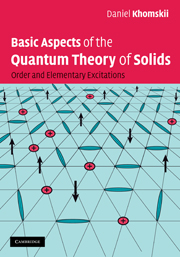Book contents
- Frontmatter
- Contents
- Foreword and general introduction
- 1 Some basic notions of classical and quantum statistical physics
- 2 General theory of phase transitions
- 3 Bose and Fermi statistics
- 4 Phonons in crystals
- 5 General Bose systems; Bose condensation
- 6 Magnetism
- 7 Electrons in metals
- 8 Interacting electrons. Green functions and Feynman diagrams (methods of field theory in many-particle physics)
- 9 Electrons with Coulomb interaction
- 10 Fermi-liquid theory and its possible generalizations
- 11 Instabilities and phase transitions in electronic systems
- 12 Strongly correlated electrons
- 13 Magnetic impurities in metals, Kondo effect, heavy fermions and mixed valence
- Bibliography
- Index
12 - Strongly correlated electrons
Published online by Cambridge University Press: 05 June 2012
- Frontmatter
- Contents
- Foreword and general introduction
- 1 Some basic notions of classical and quantum statistical physics
- 2 General theory of phase transitions
- 3 Bose and Fermi statistics
- 4 Phonons in crystals
- 5 General Bose systems; Bose condensation
- 6 Magnetism
- 7 Electrons in metals
- 8 Interacting electrons. Green functions and Feynman diagrams (methods of field theory in many-particle physics)
- 9 Electrons with Coulomb interaction
- 10 Fermi-liquid theory and its possible generalizations
- 11 Instabilities and phase transitions in electronic systems
- 12 Strongly correlated electrons
- 13 Magnetic impurities in metals, Kondo effect, heavy fermions and mixed valence
- Bibliography
- Index
Summary
In the previous section we have already seen that in the case of strong electron–electron interactions, when the average interaction energy becomes larger than the corresponding kinetic energy, one can expect drastic changes of the properties of the system. Notably, the electrons will have a tendency to localize, so as to minimize their repulsion at the expense of a certain increase in kinetic energy. Materials and phenomena for which this factor plays an important role are now at the centre of activity of both experimentalists and theoreticians; this interest was especially stimulated by the discovery of high-Tc superconductivity in which electron correlations play a very important role. But even irrespective of the high-Tc problem, there are a lot of other interesting phenomena which are connected with strong electron–electron interactions. These phenomena include electron localization, orbital ordering and certain structural phase transitions, insulator–metal transitions, mixed valence and heavy fermion behaviour. The very existence of localized magnetic moments in solids, both in insulators and in metals, is actually determined by these correlations. That is why this is one of the most actively studied classes of phenomena at present.
Real materials to which one applies the models and the treatment presented in this chapter are mostly transition metal and rare earth compounds, although general ideas developed in this context are now applied to many other systems, including organic materials, nanoparticles or supercooled atoms. The typical situation in transition metal compounds is the one with partially filled d-shells.
- Type
- Chapter
- Information
- Basic Aspects of the Quantum Theory of SolidsOrder and Elementary Excitations, pp. 229 - 271Publisher: Cambridge University PressPrint publication year: 2010



